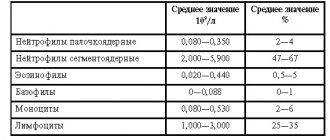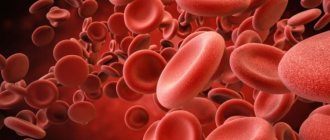High-quality medical care in the modern world is impossible without many diagnostic tests that help determine the patient’s condition, give an idea of the functioning of his organs and systems, and also determine the diagnostic search at the stage of diagnosis.
INR (international normalized ratio) is a research method that can tell a lot about the patient’s blood clotting characteristics.
Doctors often use INR analysis both to assess the function of the patient’s blood coagulation system and during therapy with indirect anticoagulants for timely adjustment of the drug dose. Often, the test is used before surgery to assess the patient's risk of bleeding.
get a high-quality INR analysis at a reasonable and affordable cost at a medical office. Our laboratory is ready to offer you modern diagnostic methods at the best price!
INR - what is it?
Blood INR in combination with a laboratory indicator such as PTT (prothrombin time) gives the doctor complete data on the state of the patient’s blood coagulation system. In fact, the INR is a numerical, artificial value, which is calculated by the laboratory using PTT and other diagnostic criteria. PTT is a value that shows how long it takes for a patient's blood to clot. Then specialists in the laboratory compare the resulting PTT value with the values accepted as the norm and calculate the deviation of the patient’s PTT from the normal value.
The calculation of blood INR occurs as follows: the laboratory determines the ratio of the patient’s PTT to the standard PTT, accepted as the norm. The result is then multiplied by the international sensitivity index, which is a standard indicator and does not vary depending on the laboratory.
There is also such an indicator as PTI (prothrombin index). In medicine, it is the direct ratio of the patient's PTV to the standard PTV.
Thus, the lower the INR, the greater the risk of blood clots in a person. The formation of blood clots threatens serious complications - for example, thrombosis of the veins of the lower extremities can lead to a critical condition - pulmonary embolism.
If the INR is significantly elevated, this means that the risk of bleeding and hemorrhagic complications increases. The patient in this case suffers from sudden heavy bleeding that takes a very long time to stop. In a healthy person, the INR ranges from 0.85 to 1.15 units. In patients taking anticoagulant therapy, the norms vary slightly - 2-3 units are considered the standard indicator.
Thus, the attending physician receives a complete picture of the work and activity of the patient’s blood coagulation system. The doctor has every reason to diagnose pathology and calculate the dosage of therapeutic drugs for diseases of the cardiovascular system.
What does it mean if the INR is elevated?
The INR is always assessed together with the prothrombin level. This study is not carried out in isolation (INR is calculated based on the patient’s prothrombin level). Therefore, the reasons for changes in the level of INR in the blood should be interpreted together with the level of prothrombin.
The INR level is inversely proportional to the prothrombin level and the amount of blood clotting factors (the higher the INR level, the lower the prothrombin level).
Most often, the INR is elevated when:
- liver diseases;
- consumption coagulopathies (conditions in which, against the background of active thrombus formation, blood clotting decreases due to depletion of blood clotting factors);
- fibrinogen and/or prothrombin deficiency;
- vitamin K deficiency.
A low INR level is observed in patients with an increased risk of blood clots, the early stage of thrombosis. Also, a decrease in INR levels can be observed in the last trimester of pregnancy.
An increase in the level of prothrombin according to Quick is observed with:
- tendency to thrombosis, development of thromboembolic conditions, myocardial infarction, pre-infarction conditions, increased blood viscosity due to hypohydration, with hyperglobulinemia;
- taking certain medications: drugs that can inhibit the effect of coumarin (vitamin K drugs, barbiturates), corticosteroids, oral tablet contraceptives, meprobamate drugs, antihistamines;
- polycythemia;
- the presence of malignant neoplasms in the patient.
When is the test ordered?
An INR analysis may be needed by a doctor of any specialty to make a final diagnosis and choose treatment tactics for a patient. Often referrals for diagnostics are given by cardiologists, obstetricians-gynecologists, hepatologists, and general practitioners.
Blood INR must be determined in the following alarming situations:
- heavy, frequent and prolonged nosebleeds in the patient, which can occur suddenly and for no reason;
- the appearance of hematomas of unknown origin in various areas of the human body;
- the patient has thrombosis of large vessels;
- anemic conditions;
- suspicion of the development of disseminated intravascular coagulation syndrome;
- the presence of persistent tachycardia of unknown etiology;
- the presence of confirmed pathology of the cardiovascular system;
- pathology of pregnancy - a woman has a history of several spontaneous abortions or episodes of miscarriage;
- features of the menstrual cycle of the female body - long, heavy menstruation, which brings significant pain;
- availability of data on the pathology of the blood coagulation system in close relatives.
Calculation of the patient's blood INR is also necessary before surgery. If there are pathological changes in the INR analysis, in some cases surgical intervention is prohibited, because the patient may develop intense bleeding on the operating table.
In addition, deciphering the INR is necessary to prescribe anticoagulant therapy to the patient in an individual dosage. When using anticoagulants, INR must be assessed regularly to adjust the treatment regimen if necessary.
Why is determining the INR so important?
The human body has the ability to self-defense, as well as self-healing. One of the devices that provides these capabilities is the hemostasis system, which maintains the blood viscosity necessary to perform the assigned functions.
That is, it controls the clotting process, namely, when bleeding occurs, a chain of chemical reactions is launched aimed at creating blood clots. The latter block the flow of blood - “seal the gaps” in the vessels, as a result of which the bleeding stops.
At the same time, in various laboratories, different thromboplastins (from several manufacturers) were used to perform this blood test - reagents that specifically trigger the clotting process. This often led to different values obtained, which alarmed both doctors and patients themselves.
In order to avoid such inconsistencies, which show different results in several laboratories, and not be tied to the standards adopted in each specific one, the INR indicator was introduced. It cannot be unambiguously called analysis, since at its core it is an ordinary mathematical calculation using a standardized formula.
Reference! The test for determining INR was approved in 1983 by two International Committees - on standardization in hematology and on hemostasis and thrombosis.
The described parameter is calculated using a specially developed formula, including the PTT of the subject and the corresponding MIC coefficient, denoting the international thromboplastin sensitivity index. According to WHO recommendations, the manufacturer must determine the MRI for each batch of reagents by comparison with a generally recognized reference index.
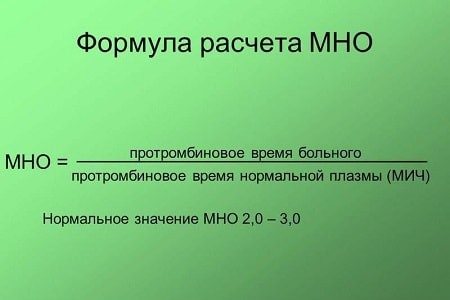
Formula for calculating INR
The use of INR provides the opportunity to compare research results made in different laboratories and at different times without fear for the condition and life of patients. This is the standard ratio used by doctors in all countries.
Therefore, it is the result of calculating the INR that is indispensable when selecting and prescribing the dosage of anticoagulation drugs, transfusion of plasma and its components, as well as other agents. In addition, such a study is necessary to determine the tactics for further treatment of patients with diseases of the hemostatic system.
What is the research used for?
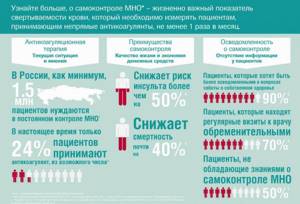
Blood INR in combination with other parameters of the blood coagulation system makes it possible to analyze the state of various links in the chain of the coagulation system. Often, the main indication for performing an INR analysis is the diagnosis of patient pathologies associated with increased thrombus formation or, conversely, increased bleeding.
In addition, doctors monitor INR quite closely and seriously in patients taking anticoagulants (drugs that prevent excessive blood clotting), which allows timely and regular monitoring of the dosage of the drug. Patients taking indirect anticoagulants (for example, Warfarin) regularly undergo an INR test so that the doctor has a complete understanding of the patient's blood condition. As a rule, when prescribing the dosage of a drug, the doctor uses international recommendations, which include, in particular, the INR , because the prescribed dose of the anticoagulant depends on the INR.
The study is also carried out to assess the degree of liver damage in severe diseases of this organ - for example, during cirrhosis of the liver or due to the development of hepatitis. The fact is that the liver is solely responsible for the production of many factors that ensure the proper functioning of the blood coagulation system.
INR analysis is an accessible and effective test that shows whether a patient has the following diseases:
- liver pathologies;
- disorders of the coagulation system - consumption coagulopathies, which are accompanied by the active formation of blood clots, which disrupts the stability of the patient’s entire blood coagulation system;
- lack of fibrinogen and prothrombin in the patient’s peripheral blood, which trigger successive stages of human blood coagulation;
- deficiency of the most important blood clotting factor - vitamin K;
- taking certain medications that affect components of the coagulation system.
If INR is less than 0.5 units, then the doctor should be wary: there is a high risk of thrombosis in the person. Often, an INR analysis shows a decrease in the indicator in the late stages of a patient’s pregnancy.
When using indirect anticoagulants in human therapy, the analysis is carried out once every 14-21 days. As soon as the doctor selects the required therapeutic dosage of the drug for the patient, the patient is prescribed a study once every 6-8 weeks.
Complexes with this research
Entry into IVF Examination when a woman enters the IVF procedure RUB 23,020 Composition
Coagulogram Study of the functional state of hemostasis RUB 2,020 Composition
Risk of severe COVID-19 Diagnosis of prediabetes and bleeding disorders RUB 1,090 Composition
IN OTHER COMPLEXES
- Female infertility RUB 16,210
- Expanded hospital complex 7,700 RUR
- For those at risk of COVID-19 RUB 4,510
- Extended coagulogram RUB 4,150
- Preventive check-up RUB 11,960
Method of determination
A standardized methodology for assessing the INR norm was adopted by a specialized international organization in 1983.
During the study, blood is taken from the patient from any peripheral vein, as with other diagnostic methods - a general blood test, biochemical blood test and other studies. In a test tube, blood is mixed with a special reagent that acts as a preservative (citrate). Citrate in a test tube is necessary to bind calcium ions and prevent the blood from quickly clotting. Then the plasma is separated from the cells in it. At the next stage, exclusively pure serum is examined.
In laboratory conditions, calcium is added to the test plasma in order to neutralize the preservative. The specialist then estimates the time it took for the clotting reaction to occur. Thus, the time obtained is an indicator of prothrombin time. Then, based on the PTT, the specialist calculates the INR.
INR = (patient PT/control plasma PT)*MICH, where:
* The PTT of control plasma is a standard measure of the PTT of capillary blood from a person who has normal amounts of coagulation factors.
Exclusively thanks to the analysis of INR, it is possible to compare without error data on the functioning of the human blood coagulation system obtained in different laboratories and at different periods of time. The INR norm is a classic standard that is used in laboratories all over the world and is assessed equally by all doctors.
What is an INR blood test?
INR is not an actual value and is calculated using mathematical equations.
The basis is the PT value (prothrombin time), the normal value of which is considered to be 11-16 seconds, and the thromboplastin sensitivity index (TSI), which is the active developing reagent. The result of the INR readings can be presented as a mathematical formula (INR = PVMICH). In most cases, such an analysis is prescribed to people taking anticoagulants who need constant and timely monitoring of blood clotting. As a result of such an analysis and correct calculation, specialists are able to obtain an accurate idea of the level of plasma in the blood, excluding errors and any external factors. Regardless of which laboratory the blood test was performed in, the results will be valid in medical institutions around the world and will be identical when deciphered. Such a blood test will allow specialists to select the required amount of anticoagulants and fully control the treatment process.
INR norm
The standardized INR norm is 0.85-1.15 units. If a person takes anticoagulants, then his INR is increased , which is natural: the patient’s blood contains fewer coagulation factors. In this case, the INR norm for the patient is 2-3 units.
The blood INR indicator is influenced by many factors, ranging from the patient’s gender and age to the characteristics of his medical history. Depending on the age of the patients, the following limits of normal blood INR are distinguished:
Table 1. INR indicator depending on the patient’s age
| Patient age | Normal INR (in units) |
| Newborn period, as well as the first year of life | 0,9— 1,25 |
| 1 year—6 years | 0,95— 1,1 |
| 12—16 years | up to 1.35 |
| over 16 years | 0,85— 1,3 |
As you can see, blood INR by age is an indicator that varies significantly depending on the category in which the patient belongs.
Indications for prescribing INR
A blood test for INR is prescribed for certain indications. The normal range of this test varies depending on the underlying disease of the patient.
Indications:
- Preoperative examination of patients. The norm is closer to 1 (from 0.7 to 1.3, usually 0.85-1.25).
- Taking blood thinners (such as Warfarin). The norm is 2.0-3.0.
- Therapy for pulmonary embolism. The norm is 2.0-3.0.
- Condition after aortic valve replacement with a mechanical implant. The norm is 2.0-3.0.
- Condition after mitral valve replacement with a mechanical implant. The norm is 2.5-3.5.
- Preventive treatment of pulmonary embolism for heart defects. The norm is 2.0-3.0.
- Preventive treatment of deep vein thrombosis after surgery. The norm is 2.0-3.0.
INR analysis for patients taking blood thinners is carried out at certain intervals, which are determined individually by the doctor. At the beginning of the disease, when the patient is in the hospital, such tests are performed daily. Next, the patient is recommended to monitor the INR once a week and, if the test results are stable, then the frequency of tests can be reduced to once every 2-3 weeks.
The following changes in the patient’s life or symptoms of hypocoagulation may be the reason for prescribing an extraordinary test:
- long-term cold or other illness;
- changing the concomitant therapy regimen;
- lifestyle or diet changes;
- sudden climate change;
- unmotivated nosebleeds;
- bleeding gums;
- causeless appearance of hematomas;
- blood in urine:
- prolonged and heavy menstruation in women;
- streaks of blood in sputum or vomit;
- blood in stool (or tarry stool);
- prolonged bleeding from cuts;
- unexplained lumps, pain and swelling in the joints while taking a blood thinner.
Interpretation of the INR analysis
The interpretation of the INR analysis is carried out exclusively by the patient’s attending physician, because he knows the characteristics of his body, medical history and medications that the person takes, which can affect the INR value.
Table 2. INR values and their possible interpretation
| The resulting indicator | Decoding |
| 0,85—1,15 | INR norm for a patient who does not have diseases of the blood coagulation system: coagulation processes are normal. |
| 2—3 | Elevated INR: the patient is probably taking anticoagulant therapy (Warfarin) due to the presence of a certain pathology - for example, atrial fibrillation; the person is undergoing treatment for pulmonary embolism; The patient is prescribed treatment due to the occurrence of thrombosis or to prevent thrombosis of large veins. |
| 2,5—3,5 | Such data are observed after installation of a mechanical mitral valve prosthesis in a patient. |
| 3,0—4,5 | This INR indicator indicates the development of diseases of the patient’s vascular bed, as well as myocardial infarction. |
It is recommended to draw conclusions about the state of the blood coagulation system based on INR analysis over time, after a series of studies. It is in this way that the doctor obtains the most complete picture of the patient’s health.
How to prepare for an INR blood test?
The analysis is given on an empty stomach. Venous blood is used for the study.
You should not smoke before the test. It is also recommended to avoid physical and emotional stress.
2-3 days before the test you should stop drinking alcohol.
The attending physician and laboratory staff should be notified about the medications the patient is taking, since some medications (anticoagulants, oral contraceptives, glucocorticoids, etc.) can affect the test parameter.
INR during pregnancy
The INR norm in women changes slightly during pregnancy. The changes are due to the fact that during pregnancy a new element appears in a woman’s body - the placental circulation. In addition, during pregnancy there are significant hormonal changes and changes in circulating blood volume, which affects changes in INR. Because of this, the INR is increased in a pregnant woman, but the increase does not reach critical values: as a rule, the indicator does not go beyond the normal limit. The PTT in pregnant women is 17-20 seconds, while in a normal healthy adult the PTT ranges from 24-25 seconds.
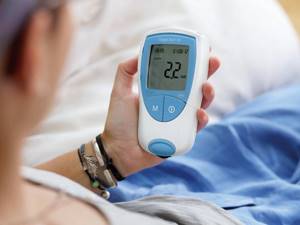
In pregnant women, INR diagnosis is carried out 3 times on an empty stomach in different trimesters of pregnancy. If the doctor has noticed changes in the INR, then when prescribing therapy, the analysis must be performed more often.
Determining the INR rate in women during pregnancy is extremely important: the value of the indicator affects a woman’s ability to bear a child and go through the stage of natural childbirth. It is especially necessary to check the INR before childbirth in order to assess a woman’s ability to give birth to a child on her own. If bleeding occurs, a situation may arise when a woman needs to be given additional medications or drugs to stop the bleeding if there is severe blood loss during childbirth.
INR decreased
If the INR analysis shows reduced values, then the patient is at high risk of developing blood clots in the peripheral vessels. The reasons for a decrease in INR may be the following:
- long-term storage of the test material at temperatures up to 4 degrees Celsius;
- drawing blood from a catheter located in the patient’s central vein;
- change in hematocrit (the ratio of the cellular fraction of blood to its liquid part);
- an increase in the level of antithrombin III or aPTT in the test blood sample;
- taking certain medications - diuretics, anticonvulsants, glucocorticoids, and oral contraceptives (for women).
If the INR is low , then it is necessary to conduct a diagnostic search to detect the causes of this phenomenon. In addition, it would not be superfluous to carry out repeated diagnostics to exclude the possibility of an error occurring when performing the study.
INR increased
An INR analysis may show elevated values if the patient is taking certain medications, for example, non-steroidal anti-inflammatory drugs - Diclofenac.
Blood INR may increase in the following pathological conditions:
- diseases of one or more parts of the blood coagulation system;
- pathology of the hepatobiliary system;
- disturbances in the gastrointestinal tract, poor absorption of fats;
- ulcerative damage to the digestive system, the presence of inflammatory changes in the wall of the stomach or intestines;
- pathology of the cardiovascular system - hypertension, pre-infarction state, development of myocardial infarction;
- pathology of cerebral vessels, cerebral disorders;
- kidney diseases;
- the presence of malignant neoplasms;
- polycythemia;
- disruption of vitamin K synthesis.
We offer you an INR analysis as quickly and efficiently as possible at the medical office! Our experienced specialists will perform blood sampling and complete diagnostics using modern equipment, and promptly provide you with the results of the study. We conduct blood INR tests in our medical center at an attractive price!
Why do you need to know the INR?
INR analysis is a common research method during the diagnosis of cardiovascular diseases. In addition, bleeding and severe thrombus formation are direct indications for studying all parameters affecting coagulation.
Knowing the INR is very important for the cardiologist who prescribed anticoagulants to the patient, since this allows him to control the correctness of the dose calculation, in order not to harm the patient. This also includes taking warfarin, the dosage of which is determined for each patient individually.
In case of cirrhosis of the liver or other disease of the filtering organ, it is also important to know the INR level, because it is the liver that produces many factors that clot the blood.
A separate group of patients are pregnant women. First of all, this is due to the fact that the entire body system begins to work differently during pregnancy. The level of hormones and enzymes changes, and the volume of blood circulating through a woman’s veins increases. Hence the need to control the functioning of the hematopoietic system. Due to the high level of blood clot formation, the likelihood of complications is high. And if the blood is too thin and there is a lack of platelets, there is a high probability of dangerous bleeding during childbirth.
At the very beginning of labor, each woman in labor is given a catheter in a vein, into which, if necessary, an IV will be placed with a composition that increases the level of blood clotting to prevent large blood losses.
Transcript of the study
Decoding the test has a principle - the higher the numbers in the blood test, the more liquid it is.
The norm in the analysis of people who do not take anticoagulants is from 0.8 to 1.15. When taking medications to prevent atrial fibrillation, the norm is 1.5 - 2. When using medications to prevent blood clots and treat diseases associated with the formation of blood clots, the norm is 2.0-3.0. In the treatment of thromboembolic lesions of the main arteries - 3.0 - 4.0. For the prevention of thrombosis after operations - 3-4.5.
Normal indicators indicate adequate treatment of patients. If the test shows an excess of the norm, then the dosage of the drugs should be reduced, as there is a risk of bleeding. At low values, the dosage of anticoagulants must be increased, as there is a risk of blood clots.
Increasing performance
If the blood test results show high numbers, especially in people taking anticoagulants, it means blood clotting. This may cause bleeding. In this case, a dosage adjustment of the drug is required.
If indicators exceed the norm in people who do not take medications that affect blood clotting, this may indicate a risk of pathologies or congenital diseases of the coagulation system.
Patients with high levels may have liver disease and impaired intestinal absorption (particularly lipids). High rates may indicate problems with the transport of bile from the liver to the duodenum.
If the test shows a significant excess of the norm (from 6 units), then the patient needs urgent hospitalization, as there is a risk of internal or external bleeding. Patients with peptic ulcers, arterial hypertension, kidney and heart diseases should know this.
Decrease in indicators
If a patient who is taking anticoagulants has low test results, it means that the dosage of the drug needs to be increased, otherwise the treatment will be ineffective. A decrease in indicators is possible in congenital pathologies of the coagulation system. In women, test results may decrease during pregnancy or after childbirth.
A decrease in INR levels may occur after injury or as a result of necrosis. In this case, tissue thromboplastin actively enters the patient’s bloodstream. Low levels occur in people with a deficiency of prothrombin in the body (congenital or acquired) or with a lack of vitamin K, which is involved in blood clotting.






